
All images © by Roberto Piperno, owner of the domain. Write to romapip@quipo.it.
Notes:
Page added in November 2025.

All images © by Roberto Piperno, owner of the domain. Write to romapip@quipo.it.
Notes:
Page added in November 2025.
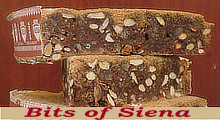 The Cathedral (exterior)
The Cathedral (exterior)You may wish to take a walk along the main streets of Siena first.
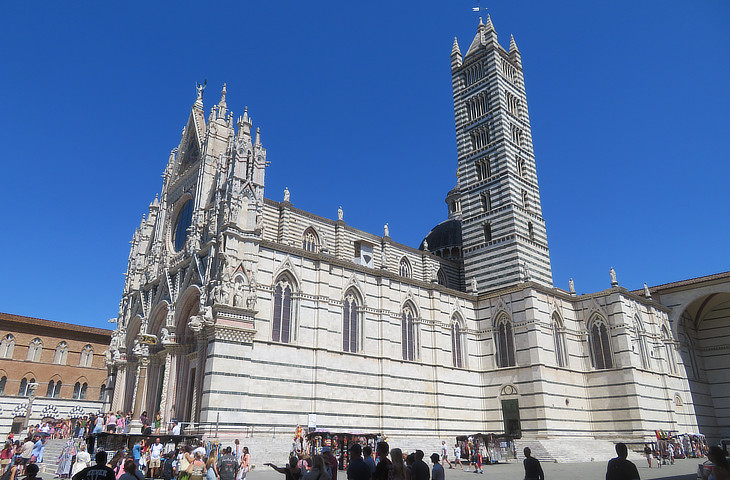
Overall view of the Cathedral (see it from a greater distance); the image used as background for this page shows a detail of the old pavement on the left side of the cathedral
Not farre from the walles on the South-side, lies the
Cathedrall Church vulgarly called Il Domo, and howsoever it be little, it seemed to me the fairest Church
in Italy. It hath but one dore, to which you ascend
by long and broad Marble staires.
Fynes Moryson - An Itinerary: Containing His Ten Years Travel Through .. Italy (in 1594)
November 1644. The Duomo, or Cathedral, both without and within, is of large square stones of black and white marble polished, of inexpressible beauty, as is the front adorned with sculpture and rare statues. In the middle is a stately cupola and two columns of sundry streaked coloured marble.
John Evelyn - Diary and Correspondence related to his stay in Italy in 1644
The Duomo or Cathedral Church is a stately edifice of marble, having a beautiful front adorned withinside with the heads of all the Popes, placed in the wall, round about the body of the Church.
John Ray - Observations topographical, moral, and physiological: published in 1673.
The prime things I saw here were these.
i. The Duomo, one of the neatest Cathedrals of Italy, though it be built a la maniera Tedescha, Its all of black and white marble within and without. The Frontispice is carved curiously and set thick with statues. Yet it wants a larger piazza before it, to give it its full grace.
Richard Lassels - The Voyage of Italy, or a Compleat Journey through Italy in ca 1668
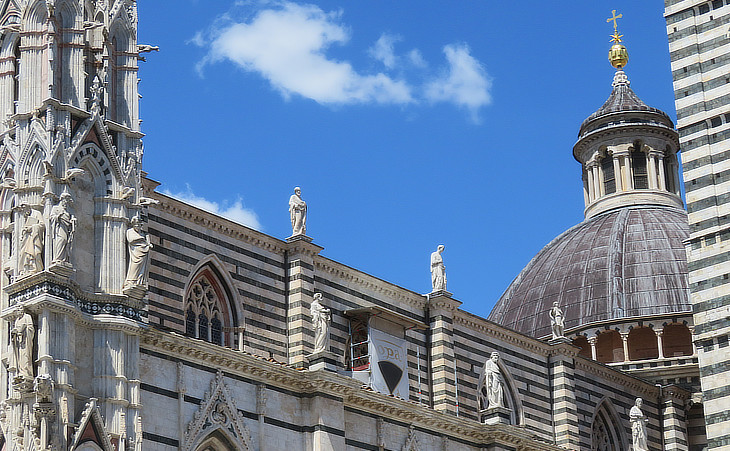
Right side with statues of the Apostles and dome with a lantern by Gian Lorenzo Bernini (see that of SS. Luca e Martina in Rome)
What Sienna has most considerable is its cathedral, a huge pile of marble, black and white laid alternately, and laboured
with a gothic niceness and delicacy in the old-fashioned way. Within too are some paintings and sculpture of considerable hands.
Thomas Gray - Letters from France and Italy in 1739-1741
In the cathedral we find marble walls polished on both sides, and built in alternate layers of black and white - a front overcharged with ornaments on the outside, and plain within - a belfry annexed, but incorporated with the pile - a cupola bearing plumb on its four supports - circular arches resting on round pillars - doors with double architraves- columns based upon lions tearing lambs. All these are peculiar to the Tuscan churches built in the Lombard style; but here too are indisputable marks of the Gothic, particularly on the front, the vaults, and the windows.
Joseph Forsyth - Remarks on Antiquities, Arts, and Letters in Italy in 1802-1803
The churches of Fossanova which was consecrated in 1208 and Casamari in 1217 have pointed arches and the Cistercian square
east end, but their central octagonal lantern towers are Italian rather than French.
These churches seem to mark the beginning of Gothic
work in central Italy. They were followed by the Duomo
of Siena, in which we find Italian Gothic fully developed. (..) The church is planned on a magnificent
scale, and shows all the peculiarities which distinguish
the Gothic of Italy from that of the North.
Thomas Graham Jackson - Gothic architecture in France, England, and Italy - 1915 (see some illustrations from this book showing the Cathedral).
The Duomo, or Cathedral, has been described with very different feelings by different travellers, some dwelling with admiration on its elaborate details, and others condemning it as an architectural absurdity deformed by the bands of coloured marble so frequently observed in Italian churches of this period, and always producing a disagreeable effect in the eyes of an English traveller. In spite of this diversity of criticism, the cathedral of Siena is beyond all question one of the most characteristic examples of the Italian Gothic, which Professor Willis has proved, by a masterly analysis of its component parts, to be susceptible of much more extended generalization in its principles than is commonly supposed. (..) The Campanile was built by the Bisdomini, and is consequently a more ancient structure than the cathedral; it has some resemblance to that of San Zeno at Verona.
John Murray - Handbook for travellers in Central Italy - 1843
Sienna is a city so full of medieval interest, whose glorious Cathedral alone might tempt the traveller to a lengthened stay, and whose inhabitants, in spite of Dante's vituperations, are all the stranger could wish to make his sojourn agreeable.
George Dennis -
The Cities and Cemeteries of Etruria - 1848 Ed.
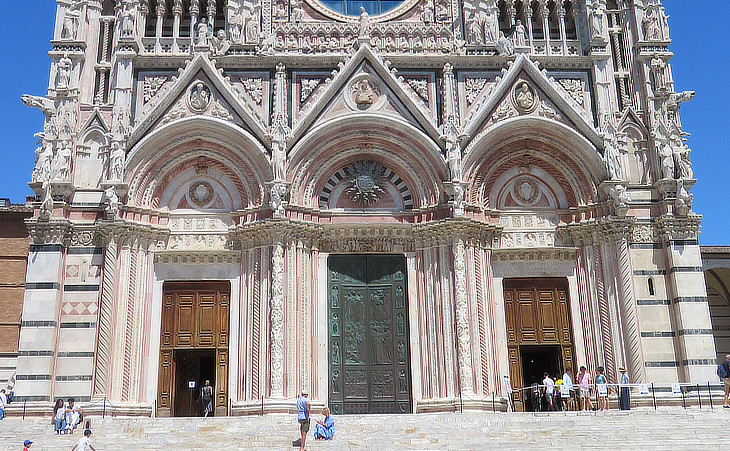
Lower part of the façade by Giovanni Pisano
There is nothing in this city so extraordinary as the cathedral, which a man may view with pleasure after he has seen St. Peter's, though it is quite of another make, and can only be looked upon as one of the master-pieces of Gothic architecture. When a man sees the prodigious pains and expence that our forefathers have been at in these barbarous buildings, one cannot but fancy to himself what miracles of architecture they would have left us, had they only been instructed in the right way; for when the devotion of those ages was much warmer than it is at present, and the riches of the people much more at the disposal of the priests, there was so much money consumed on these Gothic Cathedrals, as would have finished a greater variety of noble buildings, than have been raised either before or since that time.
One would wonder to see the vast labour that has been laid out on this single cathedral. The very spouts are loaden with ornaments; the windows are formed like so many scenes of perspective with a multitude of little pillars retiring one behind another; the great columns are finely engraven with fruits and foliage that run twitting about them from the very top to the bottom; the whole body of the church is chequered with different lays of white and black marble, the pavement curiously cut out in designs and scripture-stories, and the front covered with such a variety of figures, and over-run with so many little mazes and labyrinths of sculpture, that nothing in the world can make a prettier shew to those, who prefer false beauties, and affected ornaments, to a noble and majestic Simplicity.
Joseph Addison - Remarks on several parts of Italy, in the years 1701, 1702, 1703
Nicola Pisano and his son Giovanni designed the lower part of the façade and Giovanni sculpted most of the statues which decorated it. The two were also involved in the design and decoration of Fontana Maggiore at Perugia.
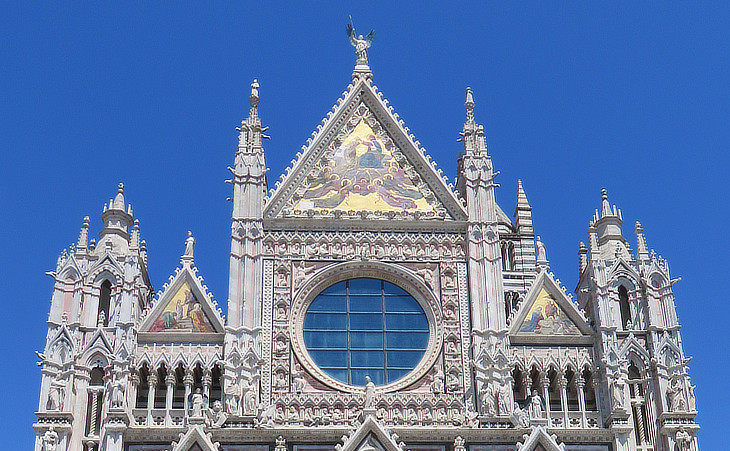
Upper part of the façade with a design similar to that of the Cathedral of Orvieto
The famous white marble façade, the work of Giovanni, son of Niccola Pisano, abounds in
magnificent detail, but it is too full of ornament and the
sculpture is overcrowded. The rose window, without which
no Italian Gothic front would be considered complete, has
some extremely beautiful painted glass, but it is too large
for external effect, and causes the middle compartment
of the upper stage in the façade to be wider than that
below. Consequently one misses the vertical division of
the composition into three parts corresponding to nave
and aisles, there being no line from top to bottom to
mark them. This is a serious defect, which is avoided
in the similar front at Orvieto. Graham Jackson
Today the design of the upper part of the façade is attributed to Camaino di Crescentino who was also involved in the construction of the Baptistery and its completion is dated 1317. At almost the same time Lorenzo Maitani, another architect from Siena was in charge of the construction of the façade of the Cathedral of Orvieto. The two are very similar and it is unclear who was influenced by whom, but the façade of Orvieto is more perfect because it does not show the disalignments between the lower and the upper parts of the façade which can be noticed at Siena.
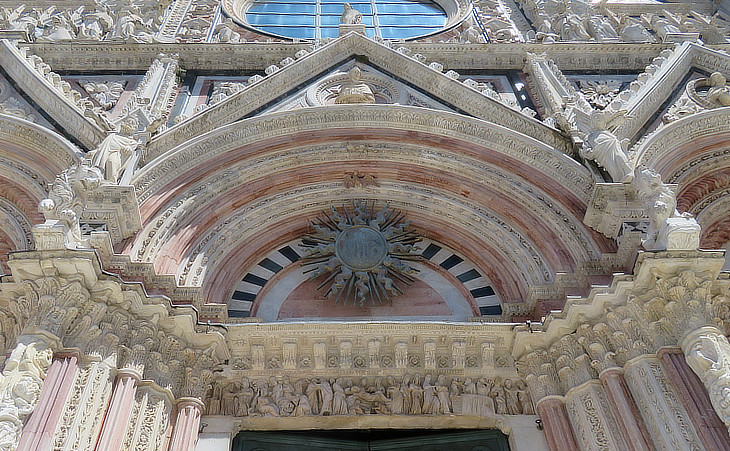
Central portal with a relief portraying Sts. Joachim and Anne and a bronze radiant sun surrounding the letters IHS, the symbol of St. Bernardino da Siena by Tommaso Redi (1630)
The front was first completed about the middle of the thirteenth century by Giovanni da Siena; but not being approved of, was demolished, the nave lengthened, and the new front begun, in 1284, it is supposed, on the designs of Niccolò Pisano. (..) It is inlaid with black, red, and white marble, relieved with other colours, painting, and gilding, and offers, a bastard pointed style, or rather a jumble of different styles; the centre porch being round, and those of the sides pointed, and the higher parts not rising insensibly out of the lower, but seeming stuck on these aprés coup; the pediments only like triangular screens or plates, placed before and unconnected with the roof. Murray
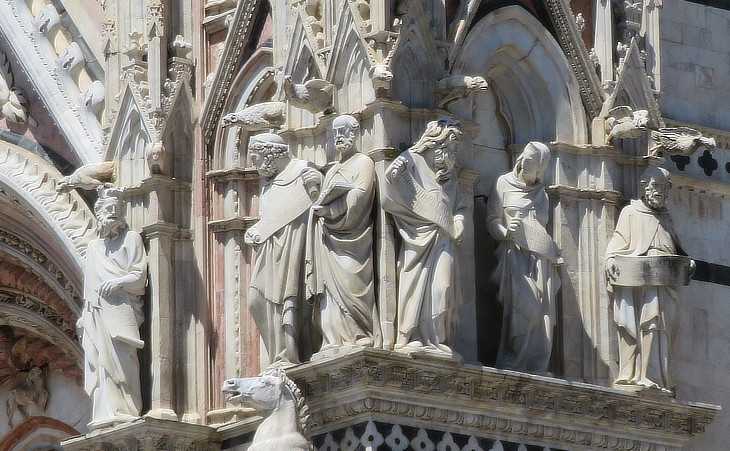
Statues of Prophets by Giovanni Pisano
The façade is covered with ornaments and sculptures, among which are several animals symbolical of the cities which were allied to Siena at different periods during the struggles of the Guelphs and Ghibelines. The she-wolf represents Siena; the stork, Perugia; the goose, Orvieto; the elephant and castle, Rome; the dragon, Pistoia; the hare, Pisa; the unicorn, Viterbo; the horse, Arezzo; the vulture, Volterra; the lynx, Lucca; and the kid, Grosseto. Over the door are busts of the three saints, Catherine, Bernardin, and Ansan, who were natives of the city. The most remarkable sculptures of this front are the Prophets and the two Angels. Murray
It is not known exactly when it was begun, but its construction was in progress during the first half of the 13th
century, and it was consecrated in 1267. The west front,
by Giovanni Pisano, dates from 1284, and was finished
within the century. He is supposed to have carried out
a design of his father Niccola, who died in 1278, and
according to Vasari had been concerned with the building
of the cathedral. Graham Jackson

Side portal with inscription celebrating the 1300 Jubilee Year and busts inside niches portraying three blessed of Siena by Tommaso Redi (1630)
September 1790. The object most worthy of the traveller's notice at Siena is the Cathedral, which as far as regards its pavement, may be deemed unique. The Duomo or cathedral church, claims particular attention, as one of the finest buildings in Italy; and a slight sketch of its history may not, therefore, be unacceptable. This metropolitan church occupies the site of a Heathen temple, dedicated to the goddess Minerva. It was consecrated for the Christian worship by Pope Alexander the Third, in 1169. In 1250, the choir was faced with black and white marble, and in the succeeding year the rest of the edifice. The marble pulpit was erected in 1266; and in 1284, the facade towards the Hospital, executed, after the design of Nicolo da Pisa, by the three sculptors Lapo, Donato, and Goro, who on that account were declared citizens of Siena. (..) In 1333, the marble facade was perfected, and adorned with various devices.
Richard Colt Hoare - A classical tour through Italy and Sicily - publ. in 1819
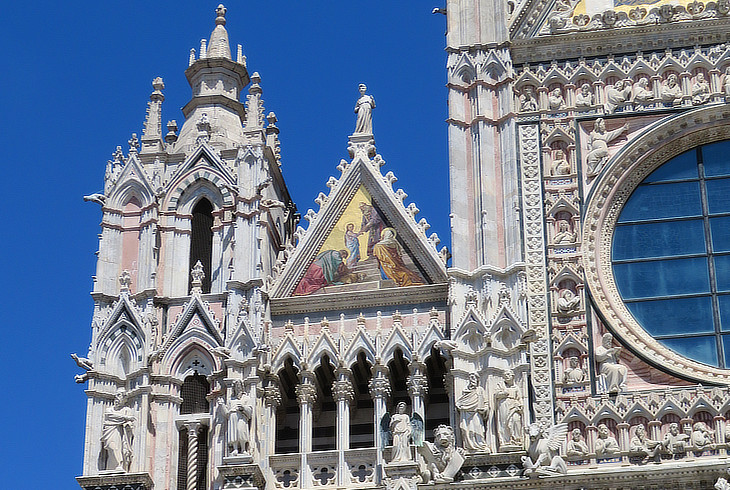
Detail of the upper part with a XIXth century mosaic
(1873) No young Sienese eyes rest upon anything youthful; they open into a world battered and befouled with long use. Everything has passed its meridian except the brilliant facade of the cathedral, which is being diligently retouched and restored. (..) The main strength of Sienese art went possibly into the erection of the Cathedral, and yet even here the strength is not of the greatest strain. If, however, there are more interesting temples in Italy, there are few more richly and variously scenic and splendid, the comparative meagreness of the architectural idea being overlaid by a marvellous wealth of ingenious detail. (..) I have sat a while every morning for a week, like a philosophic convalescent, watching the florid facade of the cathedral glitter against the deep blue sky. It has been lavishly restored of late years, and the fresh white marble of the densely clustered pinnacles and statues and beasts and flowers flashes in the sunshine like a mosaic of jewels. There is more of this goldsmith's work in stone than I can remember or describe; it is piled up over three great doors with immense margins of exquisite decorative sculpture - still in the ancient cream-coloured marble - and beneath three sharp pediments embossed with images relieved against red marble and tipped with golden mosaics. It is in the highest degree fantastic and luxuriant - it is on the whole very lovely.
Henry James - Italian Hours - 1909
The white marble which was used for the statues which decorate the façade of the Cathedral was quarried in the proximity of Siena and it did not stand the test of the time. In the second half of the XIXth century all the statues and marble decorations of the façade were replaced by copies and the originals were moved to Museo dell'Opera del Duomo.
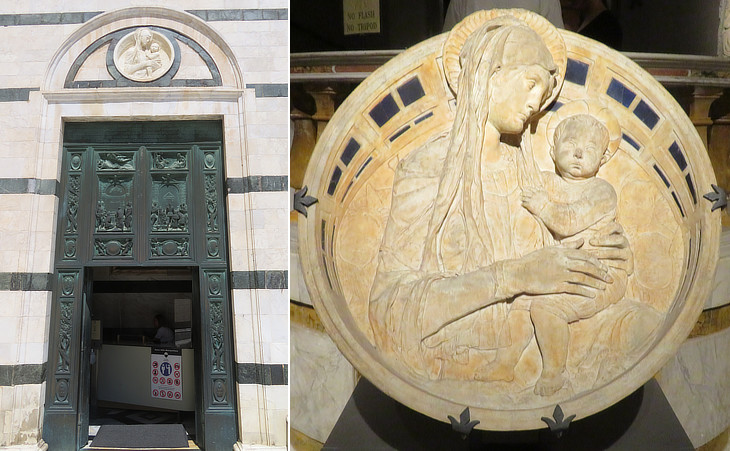
(left) Porta del Perdono (Forgiveness); (right) tondo by Donatello now at Museo dell'Opera del Duomo
Passing through Siena on his way back to Florence, he undertook to make a door of bronze for the Baptistery of S. Giovanni; and he had already made the wooden model, and the wax moulds were almost finished and successfully covered with the outer mould, ready for the casting, when there arrived, on his way back from Rome, one Bernardetto di Mona Papera, a Florentine goldsmith and an intimate friend of Donato, who wrought upon him so strongly both with words and in other ways, either for some business of his own or for some other reason, that he brought him back to Florence; wherefore that work remained unfinished, nay, not begun. There only remained in the Office of Works of the Duomo in that city a S. John the Baptist in bronze by his hand, with the right arm missing from the elbow downwards; and this Donato is said to have done because he had not been paid in full.
Giorgio Vasari - Lives of the most eminent painters, sculptors & architects - transl. by Gaston Du C. De Vere
The original right side entrance to the Cathedral was demolished in 1660 to make room for the Chigi Chapel. The tondo by Donatello was moved to a new side entrance leading to the transept. It is one of the last works of that great Florentine master who in 1457 was in Siena because he was commissioned the bronze doors of the Baptistery, a project which was never completed. A chapel of the Cathedral houses another work by him, a bronze statue of St. John the Baptist.

Duomo Nuovo and entrance to Museo dell'Opera del Duomo
In 1338, at a period when the population of Siena amounted to one hundred thousand souls, the inhabitants began to enlarge their cathedral; but the fatal mortality of 1348 put a stop to their works, and the funds which had been raised for the execution were applied to other purposes more necessary. Colt Hoare
The patriotic ambition of the Senesi was not content with their cathedral, however magnificent, and it was no sooner finished than they wanted to double its size. The present cathedral was to serve as the transept to a much vaster fane. Lando di Pietro, a Sienese architect,
was summoned from Naples, and an enormous nave was
actually begun on the south side, of which the side and
end walls and one aisle were actually built. Then came the black death of 1348, and Siena constant wars with neighbouring states, and there seem also to have been some structural difficulties. (..) The proportions of the projected nave are immense, the span of the
arches being nearly 40 feet and the width of the nave
50 feet. The plan must have involved the destruction of
the dome and the transept, for the pillars carrying them
would have been in the middle of the proposed nave,
and even had they been left they would have had no
abutment. That this destruction was intended seems
certain, for the new nave is so planned as to get the area
of the dome central with it, and this is perhaps the
explanation of the advice given by some Florentine
architects who had been consulted, to pull down a great
part of what had been done and to begin again. Graham Jackson
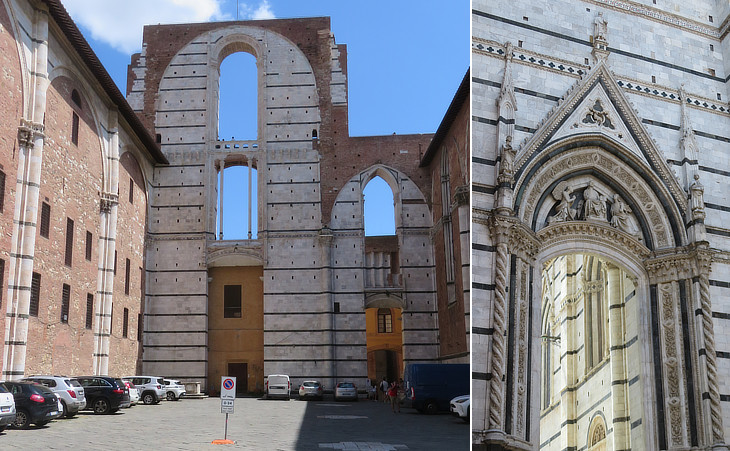
Duomo Nuovo:(left) "il Facciatone" the unfinished structure of the façade which is visible also from Piazza del Campo; (right) Portale di Vallepiatta, side portal between the Cathedral and the Baptistery (also the statues of this portal are replaced by copies - see the original ones)
A lofty flight of steps (from the Baptistery) leads through a beautiful marble gate, in the pointed style, to the piazza of the duomo. Murray
In 1355 the decision to abandon the project of building a new cathedral was taken and the side nave which was already completed was turned into a workshop for the completion of the existing building. Today it houses Museo dell'Opera del Duomo.
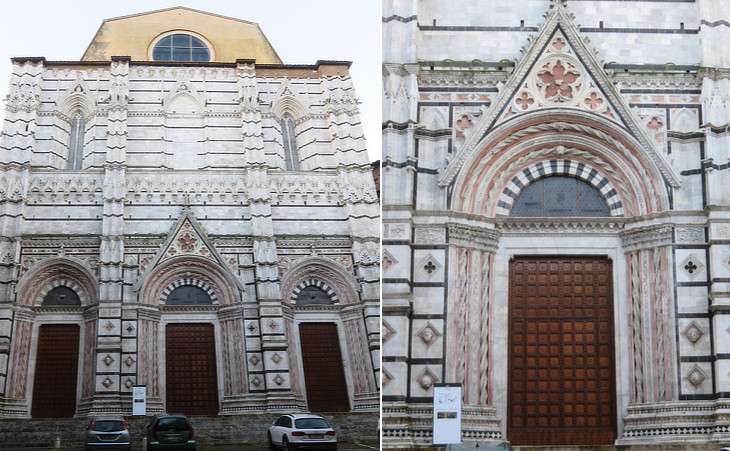
(left) S. Giovanni Battista, the Baptistery; (right) central portal
Under the cathedral, or rather under the choir, is the ancient Baptistery, now the church of St. John the Baptist; a long flight of steps descends into it. Its front is a much purer Gothic than the cathedral; the floor bears the date of 1486. Its pilasters are pannelled in lozenges, alternately with quatrefoils,
heads exquisitely beautiful. Murray
At the east end the ground falls precipitously, so that
under the choir there is a lower church, dedicated to
S. Giovanni Battista, and serving as a baptistery, which
is entered on the level from a street behind the cathedral. Graham Jackson
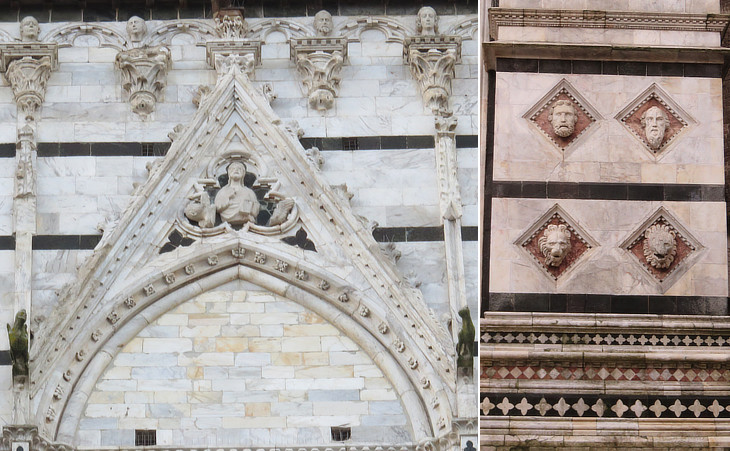
Baptistery - details: (left) upper central window; (right) heads of prophets or saints and of lions
The construction of the Baptistery is attributed to Camaino di Crescentino whereas the design of the marble façade is a work by Domenico di Agostino. In 1382 the decoration of the façade was stopped and it is still unfinished. See its interior.
Move to.
From Porta Camollia to S. Domenico
Piazza del Campo
Cathedral - Interior
Museo dell'Opera del Duomo
S. Maria della Scala

